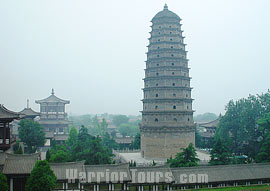- Big Wild Goose Pagoda & Tang Dynasty Palace
- Bell/Drum Tower & Daxingshan Temple
- City Wall
- Forest of Stone Steles Museum & Banpo Museum
- Great Mosque
- Huaqing Hot Springs & Xingjiao Temple
- Mausoleum of the First Qin Emperor
- Mausoleum of Western Han Emperor Liu Qi
- Terracotta Warriors
- Shaanxi History Museum
- Small Wild Goose Pagoda
- Famen Temple & Xianyang Museum
- Maoling Mausoleum & Tomb of Huo Qubing
- Mt. Huashan
- Qian Mausoleum & Zhaoling Mausoleum
Famen Temple & Xianyang Museum

![]() Famen Temple
Famen Temple
Located in Famen Town in Fufeng County, about 120 km (74.57 miles) west of Xian City, Famen Temple is one of the most important Buddhist temples in the world because of the precious veritable Finger Bone (sarira) of Sakyamuni it houses.
According to the Buddhist records, Famen Temple was originally built during the end of the Eastern Han Dynasty (25-220) to store the holy Finger Bone of the Sakyamuni, the founder of Buddhism. The temple became the royal temple in the Tang Dynasty (618-907) and emperors of the Tang Dynasty came to worship the Finger Bone many times. In 874, the Finger Bone was buried in the Underground Palace under the Famen Temple Pagoda with many royal oblations, and the secret of the treasures were kept for thousands of years. In 1987, the Underground Palace was found by archaeologists when they were trying to rebuild the Fanmen Temple Pagoda. The sovereign Finger Bone as well as two thousand precious cultural relics of the Tang Dynasty finally came back to the world!
For better preservation of these rare treasures, Famen Temple Museum was built in 1989.Golden and silver wares, glass, china, stone and iron wares, wood, genuine pearls, jades and many kinds of drygoods are housed in it. Among all the treasures, a gold-plating Buddhist abbot's staff with a length of 1.96 meters (6.43 ft) is the oldest and biggest Buddhist object ever found. It also includes 13 pieces of royal china that could not be made today because the techniques of making them have already disappeared.
Since the treasures are in huge quantity and great quality, Famen Temple is really a must-see for both visitors and pilgrims!
| Admission Fee: | Famen Temple CNY 28 Famen Temple Museum CNY 50 (Mar. to Nov.) CNY 30 (Dec. to Feb.) |
| Recommended Time for a Visit: |
Three hours |
| Bus Route: | Take Tourism Bus No. 2 at the Railway Station |
![]() Xianyang Museum
Xianyang Museum
As one of the most famous museums in China, Xianyang Museum was opened to the public in 1962 on the site of a Confucian temple of the Ming Dynasty (1368-1644). Xianyang was the capital of the Qin Dynasty (221B.C.-206B.C.), and many mausoleums of the Han Dynasty (206B.C.-220) have also been discovered here. As such, the museum mainly preserves the priceless culture relics of Qin and Han dynasties.
Covering an exhibition area of 1,100 sq meters, the museum consists of nine showrooms and a stele corridor. No.1, 2 and 3 showrooms exhibit cultural relics such as copper and golden coins, jade, pottery and even building materials of the Qin Dynasty. Showroom No. 4 displays some calligraphy and paintings of modern celebrities. The most striking cultural relics in Xiangyang Museum, the Han Dynasty Terra-cotta Soldiers, which are as grand as the Qin Terra-cotta Army, are well preserved in showroom No. 5 and 6. The 3,000 terra-cotta soldiers were excavated in Xianyang, 1965. The figures are colorful and vivid, showing the impressive manner of the royal soldiers of Han Dynasty. Showroom No. 7, 8 and 9 mainly display religious relics. A copper statues of Sitting Buddha made in the Ming Dynasty is the largest one of its kind. In addition, the newly opened Stele Corridor exhibits hundreds of ancient steles covered by marvelous calligraphy and carvings.
| Admission Fee: | CNY 20 |

